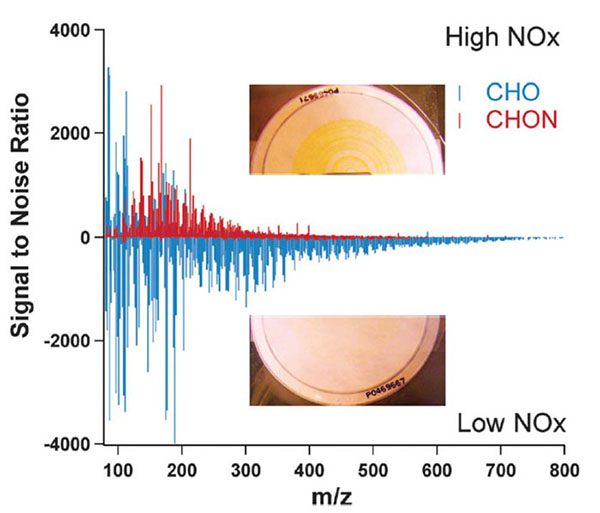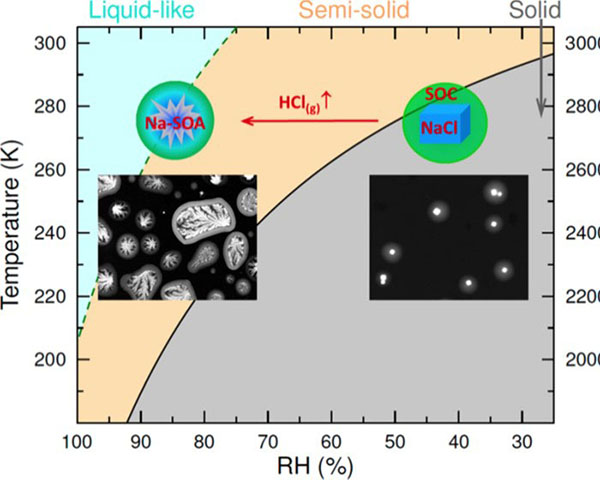Past Laboratory Experiments
Composition and optical properties of laboratory proxies of organic aerosol
partnership with S. Nizkorodov (UCI), J. Laskin (Purdue), Y. Rudich (Weizmann Institute)
The chemistry of organic aerosols (OA) is an area of great uncertainty in atmospheric research. We conduct molecular-level laboratory studies of the composition and atmospheric aging of model biogenic and anthropogenic SOA. We investigated the effects of the relative humidity, UV photolysis, evaporative processing, and aerosol particle size and reaction time on the SOA composition. Our most recent work is focused on the chemical aging of SOA leading to the formation of "brown carbon" compounds that change optical properties of particles, which in turn may have a profound effect on the atmospheric environment and climate. We determined that browning chemistry occurs in a broad range of anthropogenic and biogenic aerosols, and we also found that browning chemistry is accelerated dramatically by evaporative cloud/fog processing of aerosols. Furthermore, our results suggest that the overall light-absorbing properties of organic aerosols may be determined by selected strong brown carbon chromophores.

Image caption: nano-DESI/HRMS spectra of organic aerosol generated under and low-NOx conditions along with the photographs of the samples, indicating distinct composition and optical properties of the aerosol produced under different initial NOx concentrations.
Relevant publications
D.E. Romonosky, Y. Li, M. Shiraiwa, A. Laskin, J. Laskin, S.A. Nizkorodov. Aqueous Photochemistry of Secondary Organic Aerosol of a-Pinene and a-Humulene Oxidized with Ozone, Hydroxyl Radical, and Nitrate Radical. Journal of Physical Chemistry A, 121, 1298–1309 (2017). doi: 10.1021/acs.jpca.6b10900
P. Lin, J. Liu, J.E. Shilling, S.M. Kathmann, J. Laskin, A. Laskin. Molecular Characterization of Brown Carbon (BrC) Chromophores in Secondary Organic Aerosol Generated From Photo-Oxidation of Toluene. Physical Chemistry Chemical Physics, 17, 23312—23325, (2015). doi: 10.1039/c5cp02563j
Reactivity of liquid and semisolid secondary organic carbon with inorganic components in individual particles
Constituents of secondary organic carbon in atmospheric aerosols are often mixed with inorganic components such as sea salt and mineral dust. Interactions between organic and inorganic condensed-phase species are not well understood. We investigate the reactions of these liquid-like and semisolid components of individual particles using a set of complementary micro-spectroscopic analyses. These reactions are driven by fast volatilization of selected reaction products and become accelerated in fine aerosols because of their high surface-to-volume ratio. The reaction extent depends on particle composition, particle phase state and viscosity, mixing state, temperature, relative humidity (RH), and reaction time. Studies in our group include development and applications of new laboratory setups for kinetic measurements employing atmospherically relevant conditions for these multi-phase particle reactions.

Image caption: Diagram showing phase state of organic material in mixed organic/NaCl particles along with illustrative images of these particles prior (right image) and after (left image) the reactions leading to formation of the homogeneously distributed organic salts of sodium and release of the gas-phase HCl.
Relevant publications
B. Wang, S.T. Kelly, R.E. O'Brien, J.E. Shilling, R.C. Moffet, M.K. Gilles, A. Laskin. Reactivity of Liquid and Semi-solid Secondary Organic Materials with Chloride and Nitrate in Atmospheric Aerosols. Journal of Physical Chemistry A, 119, 4498−4508, (2015). doi: 10.1021/jp510336q
B. Wang, A. Laskin. Reactions Between Water-Soluble Organic Acids and Nitrates in Atmospheric Aerosols: Recycling of Nitric Acid and Formation of Organic Salts, Journal of Geophysical Research-Atmospheres, 119, 3335–3351, (2014). doi: 10.1002/2013JD021169
Y. Liu, B. Minofar, Y. Desyaterik, E. Dames, Z. Zhu, J.P. Cain, R. J. Hopkins, M. K. Gilles, H. Wang, P. Jungwirth, A. Laskin. Internal Structure, Hygroscopic and Reactive Properties of Mixed Sodium Methanesulfonate - Sodium Chloride Particles. Phys. Chem. Chem. Phys., 13, 11846–11857, (2011). doi: 10.1039/C1CP20444K.
